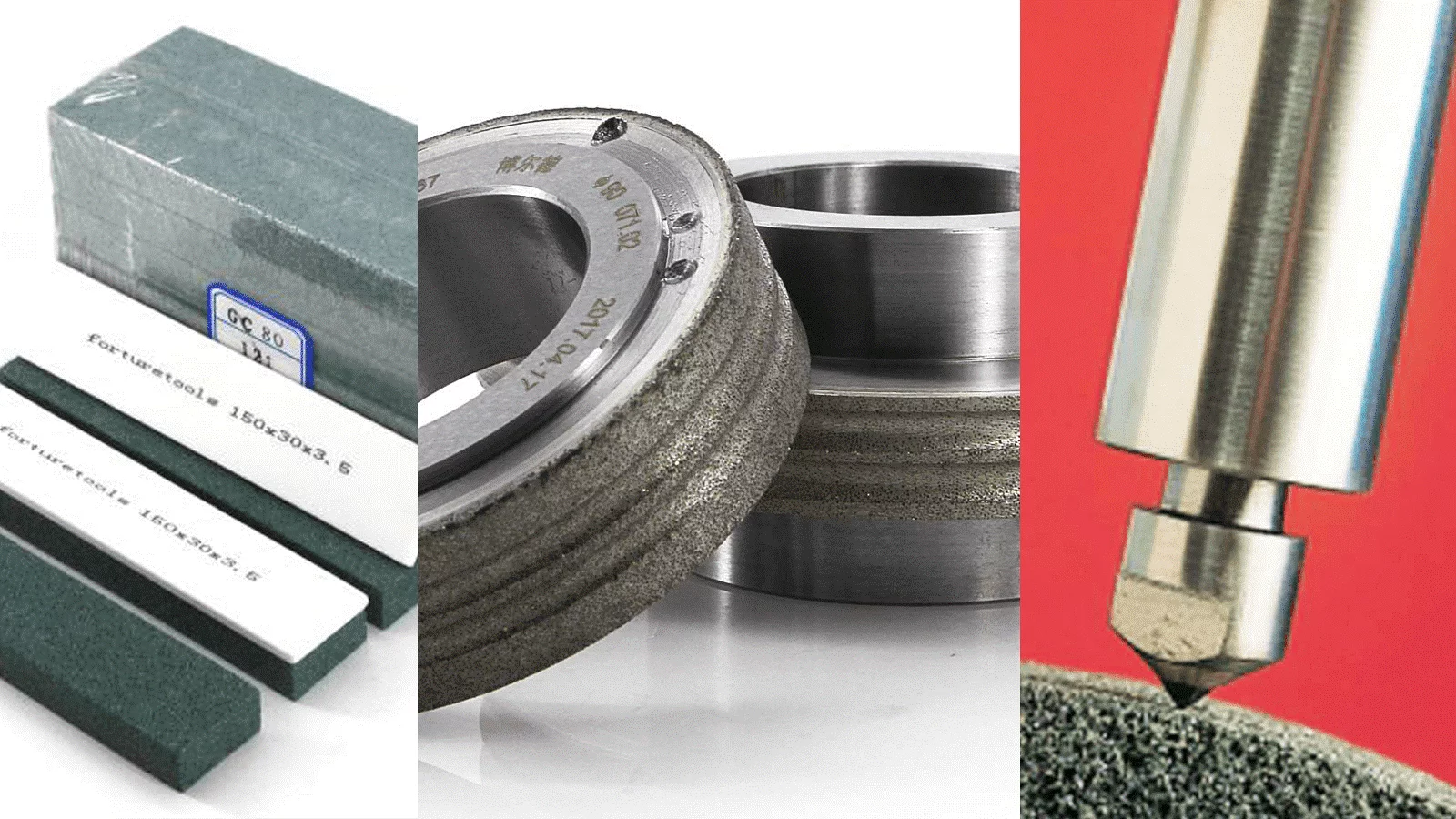Wheel dressers are essential tools designed to care for and maintain grinding wheels. The extended service life of a grinding wheel can be guaranteed when it’s properly and regularly maintained. With good maintenance, a grinding wheel will be trouble-free and perform at maximum efficiency.
Do you need a dressing tool for your abrasive wheel? It’s essential to understand some basic things about it. Your choice should be influenced by several factors, including opting for tools with proper size, shape, and quality. In case you find it challenging to choose a wheel dresser that can work best for your task, you can contact us for a fruitful discussion.
Dressing and Dressing Tools for Grinding Wheels
Dressing tools are also known as wheel dressers. They are used to clean, profile, dress, and refresh the grinding surface of different specialized tools suspended in a phenolic resin, silicone, rubber, or related compound, including CBN Tooling, Diapol Diamond Polishers, Diamond Grinding Wheels, and EVE Rubber Silicone Polishers.
Dressing may be required when a grinding wheel begins to produce parts with inconsistencies. It’s a process that involves the removal of clogs, grains, and too much bonding material from the grinding wheel. With this, the wheel can have its original surface sharpness and finish back. Besides, dressing can restore the shape of a grinding wheel, which changes due to wear.
Wheel dressing will remove any abrasive particles from the surface of the wheel, ensuring that it’s concentric and balanced. With this, vibrations due to excessive buildup on the surface can be effectively reduced. When abrasive particles are left to thrive on the wheel’s surface, they can overwhelm the surface abrasives, making them blunt/dull and ineffective. If this occurs, there will be a need to expose them by getting rid of the particles. One crucial thing to put in mind is choosing the proper dressing tools. This is a way to achieve a successful wheel dressing.
What are the Benefits of Dressing a Grinding Wheel?
Several manufacturing industries use grinding wheels for the production of precise and quality parts. For this work to be done effectively, dressing the wheels after being used overtime is necessary. This will also help maintain the shop’s productivity requirements.
The more you use a grinding wheel to produce parts, the more its surface wears away. But by dressing the wheel from time to time, good service life and maximum efficiency of the wheel can be achieved for continuous production of high-quality parts.
What are the Types of Dressing and Tools for Grinding Wheels?
There are two basic methods when it comes to dressing. These include truing and standard dressing.
- Truing: This is a dressing method performed during installation. Operators can easily straighten wheels and form them into any preferred shape through truing.
- Standard dressing: This method is used throughout the grinding process. It’s performed when needed to remove material to achieve an excellent surface finish.
Apart from the dressing methods, there are also the types of tools available for use. What you use for your grinding wheel will depend on the needed cycle time and if the wheel needs to be dressed or trued. Below are the three main types of dressing tools:
- Diamond Dressers
Diamonds are popular stones that manufacturers used to produce some great dressing tools. They are not only elegant and shining but also durable and hard, allowing them to reshape and score dressing wheels exceptionally. Diamond dressers are of different types, including multiple-point, single-point, etc. Each is used based on the job involved.
- Rotary Dressers
Rotary dressers are high-precision grinding dressing tools designed for profiling wheels. They are used by several high-tech industries that are into the production of high-precision machine parts. Why are rotary dressers considered an excellent option for OD, ID, centerless, and double-disc grinding grinders? This is because they can be tied into available grinding machine controls.
- Dressing Stones/Sticks
Dressing stones are a common type of dressing tool. They are designed to profile, dress, and sharpen grinding wheels. They are wheel dressers produced with silicon carbide or aluminum oxide, which explains the reason they are the ideal tool for dressing grinding wheels. Do you need a dresser that can offer your wheel the best surface finish? Aluminum oxide dressing sticks can be recommended. They are tools that are usually used on tools made from diamonds. Based on the standard properties of these dressers, aluminum oxide can sharpen diamonds easily.
Important Tips on Dressing for Grinding Wheels’ Users
For every grinding process, dressing plays a very crucial role. So, operators of grinding wheels must pay proper attention to some things for a great dressing to occur. Below are the tips to take seriously:
- The machine should warm-up: Wheel balance and position may be different when spindle bearings are cold compared to when they are warm. So it’s advisable to create a situation that looks like the normal grinding conditions before starting the dressing process. The dressing is expected to be at constant speeds in terms of RPMs and traverse rate.
What determines the traverse rate is the grinding type being performed. A high finish is offered by a slow traverse, but a too-slow one will glaze the wheel. To have a wheel that cuts impressively free, fast traverse rates must be involved. To remove diamond marks, you should perform the last pass in the opposite direction from the previous one.
You should ensure that the RPMs of the wheel are close (not higher) to the normal operating speed during grinding. Nonetheless, you should set the RPMs high when you’re dressing the regulating wheel of a centerless grinder.
- The dressing tool should be appropriately positioned: Operators should position the tool near or at the horizontal center of the wheel. The wheel will be tapered if the diamond is too low or high. On internal grinders, this will be of greater importance compared to external ones.
In grinding, the wheel or work contact is where the work piece and the wheel’s circumference meet. It’s crucial that diamond tools dress the grinding wheel closely to this contact area.
You should employ a drag angle which means correctly positioning the dressing tool. To do this, point it toward the direction the wheel moves. This way, you can minimize chatter and avoid gouges from showing up on the wheel. For the internal grinding process, the position of the tool should be 10-15° from the centerline and contact point of the wheel.
Note: You may damage the diamond if you approach it from the side or other angles.
- Vibration should be reduced or eliminated: Vibration can effectively be minimized when the tool is tight in its holder. Also, it will minimize chatter, gouging, and marks on the wheel.
- Avoid cutting deep: For finishing, cutting less than 0.001 in. is advisable. Although cutting deep can make the process faster, it may leave diamond marks on the grinding wheel and your work piece. Besides, deep cuts can generate excess heat, making the diamond wears off more.
- Lots of fluid should be used: You can dress your wheel with/without fluid. If you’re grinding wet, use fluid to dress wet. But if you’re grinding dry, then dress dry. You should perform passes in 3-5 seconds intervals when dressing dry to cool the diamond. With this, you can increase your wheel’s service life and reduce its burning. In addition, you should point coolant nozzles in a way that can make fluid gets to the entire face of the wheel. Besides, you should filter the coolant.
- Sharp tools are recommended: You get a sharp point for use with the frequent truing of the diamond. The wheel’s pores are packed by dull tools with particulate, offering a dull surface. You should understand that dull and sharp diamonds will not provide similar results.
- Avoid handling carelessly: Your dresser is important and should be handled with care. Shock to the diamond is created if you bump the tool into the wheel, resulting in damage.
Conclusion
Dressing tools for grinding wheels are essential. By dressing a wheel, you can maximize the longevity and performance of the grinding tool. Since there are different types, you should look for the suitable one for your wheel. But if you find it challenging, you can get in touch with us.

